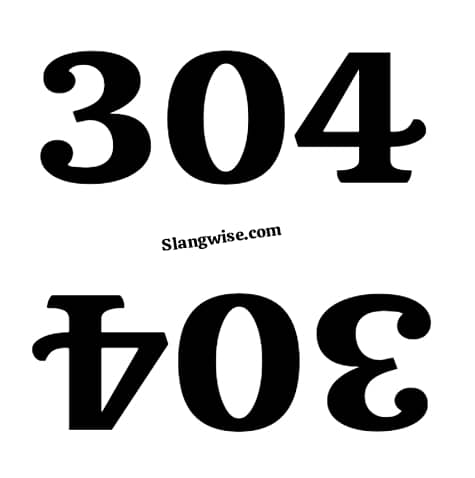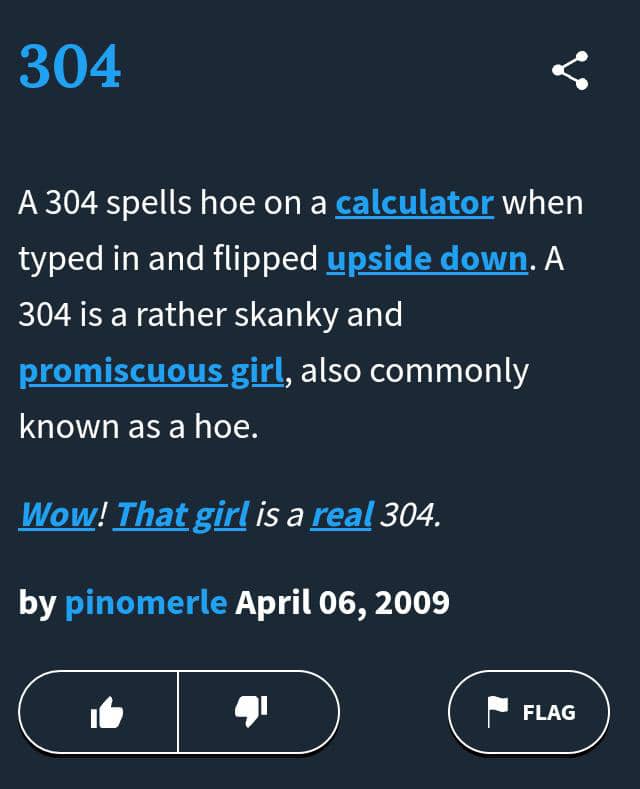TikTok’s rapid-fire slang often masks deeper meanings behind seemingly innocent codes. One such term is 304. Meer looking at it, it’s just a number, but when you flip it upside down on a calculator, it spells hoe.
On TikTok, 304 is a cheeky stand-in for that word, used to call out promiscuous or attention-seeking behavior without saying it outright.
In this post, I’ll unpack what 304 means, trace its origins in early internet culture, explore how TikTokers use it today, and share a Slangwise Tip for wielding it responsibly.
Table of Contents
In a Nutshell

- 304 = hoe when viewed upside down on a calculator.
- Origin: Mid-’90s internet chatrooms repurposed calculator text tricks.
- TikTok Usage: Labels flirtatious or promiscuous behavior in captions and comments.
- Cultural Impact: Allows creators to skirt censorship while discussing taboo topics.
Slangwise Tip: When you use 304, pair it with context, like a playful emoji or clarifying caption, to ensure viewers catch the intended tone, not a harsh judgment.
What does 304 Mean on TikTok?
In TikTok slang, 304 serves as a coded label for someone perceived as overly flirtatious, promiscuous, or simply seeking attention. Rather than calling someone a hoe directly, which risks platform moderation or simply sounds blunt, users opt for 304 to make the same point with a wink.

Common uses include:
- “She’s acting like a 304 in this trend.”
- “Don’t pull 304 moves on the dance floor.”
- “His 304 energy is off the charts.”
It’s important to know that 304 often carries a judgmental edge, though some creators reclaim it playfully, using it for self-deprecating humor.
RELATED : 65 Viral TikTok Slang Words of 2025
Origins: Calculator Speak & Early Internet Culture
- Calculator Text Tricks (1980s–’90s):
- Schoolchildren discovered that typing numbers like 0.7734 (“hellO”) or 304 and flipping the calculator upside down spelled words.
- Online Chatrooms (Mid-’90s):
- On AOL Instant Messenger and IRC, users adopted these number codes to share hidden messages.
- By 1996, Wired magazine had noted the popularity of calculator-flipped slang in digital subcultures.
- Migration to Social Media:
- The trick faded as rich text became common online, but found new life on TikTok around 2022, where short numeric codes fit the platform’s fast pace.
How TikTokers Use 304 Today
1. Captioned Call-Outs
Creators tag dramatic or flirtatious clips with #304, signaling viewers to laugh at or critique the subject’s behavior.
2. Comment-Section Shade
Responding to someone’s overly flirtatious reply, commenters drop 304 to subtly shame without explicit profanity.
3. Trend Participation
Challenges like “Don’t Be a 304” encourage users to showcase non-promiscuous fun, dances or pranks that avoid “slut-shaming” clichés, ironically highlighting the coded term.
Emily Jones Perspective
Calculator-based codes like 304 exemplify how online communities develop covert language to navigate moderation and social taboos,” notes Dr. Emily Jones, sociolinguist at NYU. “They foster in-group identity but can also perpetuate judgmental attitudes toward sexuality.
Implications of Using 304 Meme
- Coded Speech: 304 lets creators discuss sexual topics under TikTok’s radar, an evolution of earlier internet censorship workarounds.
- Judgment & Reclamation: While often used to shame, some TikTokers reclaim 304 in tongue-in-cheek self-descriptions, flipping its power.
- Gender Dynamics: Similar to terms like simp, 304 can reinforce double standards about men’s versus women’s sexual expression.
Slangwise Tip on 304 usage
If you want to call out behavior without shaming individuals, frame 304 in hypothetical or third-person scenarios, ‘Ever seen someone pull 304 moves at brunch?’, to keep it light and less personal.
Conclusion
304 exemplifies TikTok’s knack for reviving vintage internet hacks in a modern context, turning calculator trickery into a slang shorthand for controversial topics.
While it’s a clever way to skirt explicit language filters, be mindful of its judgmental roots. By using 304 with context, humor, and respect, you’ll stay both on-trend and considerate, a true TikTok insider.
FAQs
Predominantly yes, but some creators use it humorously or self-referentially.
Absolutely. Because it equates to a derogatory label, use it sparingly and with clear intent.
Yes, numbers like 0.7734 (“hELL0”) or 5318008 (“BOOBIES”) follow the same calculator-flip logic for playful (sometimes risqué) messages.

